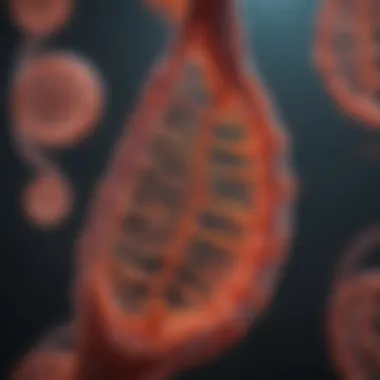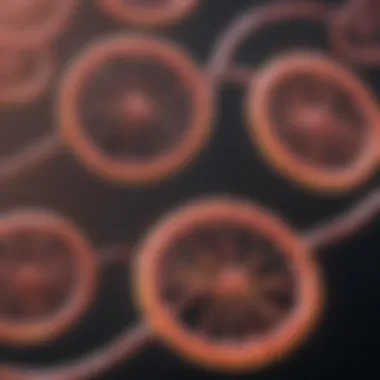Mitochondrial DNA Staining: Techniques and Applications


Intro
Mitochondrial DNA staining is a pivotal technique in the realm of cellular biology. It facilitates the visualization and analysis of mitochondrial DNA, offering insights into cellular function and genetic disorders. Understanding this methodology aids researchers, educators, and professionals in deciphering the complexities of mitochondrial diseases and genetics.
Furthermore, with the rise in interest surrounding mitochondrial health, the implications of mitochondrial DNA staining have become more pronounced. This article aims to unfold the intricacies of mitochondrial DNA staining, addressing its techniques, applications, and implications within the scientific community.
Research Overview
The exploration of mitochondrial DNA staining has revealed considerable findings in its various applications. From understanding metabolic processes to diagnosing genetic conditions, the methodologies employed have sophisticated over recent years.
Summary of Key Findings
Research indicates that mitochondrial DNA plays a crucial role in bioenergetics and cellular signaling. Notably, studies have shown that alterations in mitochondrial DNA can lead to significant health issues, emphasizing the need for reliable staining techniques. The correlation between mitochondrial function and several diseases, such as diabetes and neurodegenerative disorders, has further strengthened the relevance of this field.
Methodologies Employed
Mitochondrial DNA staining methods generally revolve around fluorescent dyes, PCR techniques, and advanced imaging systems. Techniques such as MitoTracker and DAPI are among the widely used fluorescent stains that allow researchers to visualize mitochondria effectively. Next-generation sequencing has also enhanced the capability to analyze mitochondrial genomic sequences, paving new paths for research into inherited mitochondrial disorders.
In-Depth Analysis
Delving deeper into the results observed from these staining techniques reveals a complex interplay of genetic factors influenced by mitochondrial integrity. Numerous studies have utilized these staining methods to unveil how mitochondrial dysfunction contributes to cellular aging and pathology.
Detailed Examination of Results
The results from studies utilizing mitochondrial DNA staining techniques yield critical data about the health of mitochondria. For instance, research has demonstrated that enhanced staining intensity correlates with increased mitochondrial biogenesis in healthy cells. Conversely, reduced staining signals can indicate mitochondrial dysfunction, a common hallmark in various diseases.
Comparison with Previous Studies
When compared to earlier methodologies, modern techniques have shown marked improvements in sensitivity and specificity. Previous approaches often struggled with nonspecific binding and background noise, impeding accurate analysis. Contemporary advancements in staining technologies, along with computational methodologies, have resolved many of these challenges, leading to more reliable outcomes in experimentation.
"Understanding mitochondrial DNA staining not only enriches our comprehension of bioenergetics but also opens doors to potential therapeutic avenues for mitochondrial diseases."
Overall, mitochondrial DNA staining remains an invaluable tool for researchers. Its applications continue to evolve, ultimately contributing to our understanding of genetics and cellular biology.
Prelude to Mitochondrial DNA
Mitochondrial DNA (mtDNA) is an essential component of cellular structure and function. Understanding mtDNA is important because it holds significant implications for genetics, evolution, and health. It is passed down from mother to offspring, thus providing a unique avenue to explore lineage and genetic disorders. Given its role in cellular processes, comprehending mtDNA becomes crucial for the study of metabolism and aging, as well as understanding disease mechanisms.
The relevance of mitochondrial DNA lies in its unique characteristics. Unlike nuclear DNA, which is inherited from both parents, mtDNA is maternally inherited. This can simplify genetic studies of populations and lineage tracing. Additionally, mtDNA encodes vital proteins involved in the electron transport chain, crucial for cellular energy metabolism. Thus, it serves as a window into the role of mitochondria in overall cellular health and function.
Understanding mtDNA and its implications is key in multiple fields. In medicine, it is linked to various mitochondrial diseases, which can have severe effects on energy metabolism. In evolutionary biology, mtDNA analysis can elucidate the evolutionary relationships between species. As a result, mitochondrial DNA staining techniques have become increasingly important in biological research, enabling scientists to visualize mtDNA within cells, assess its function, and identify any anomalies.
As we proceed through this article, we will explore the structure and function of mitochondrial DNA, its role in cellular metabolism, and the various staining techniques employed to visualize this critical component of cellular life.
Overview of DNA Staining Techniques
Understanding DNA staining techniques is crucial in the study of mitochondrial DNA. These techniques allow researchers to visualize and analyze cellular processes at the molecular level. Mitochondrial DNA staining plays a significant role in identifying and quantifying DNA, aiding in both basic research and clinical diagnostics.


Proper staining techniques can reveal details about mitochondrial function, structure, and pathology. This may include observing the integrity of DNA and its distribution within the cell. By employing various staining methods, researchers can explore different aspects of mitochondrial health and function, leading to advancements in genetics and cell biology.
Types of DNA Stains
There are numerous types of DNA stains utilized in research. Some stains target DNA non-specifically, while others provide more specific interaction with certain types of DNA.
- Ethidium Bromide: This classic dye intercalates into DNA, emitting fluorescence upon exposure to UV light. Useful in agarose gel electrophoresis, it allows for easy visualization of DNA fragments.
- SYBR Green: This is a more sensitive fluorochrome that binds to double-stranded DNA. Its applications include quantitative PCR, where it aids in quantifying DNA concentrations in samples.
- Hoechst Dyes: These compounds can penetrate living cells, allowing for studies on live cells. They bind to DNA and fluoresce under UV light, which is valuable for counting cells in culture.
- DAPI (4',6-Diamidino-2-Phenylindole): DAPI is commonly used for fixed cell staining. It emits blue fluorescence when bound to DNA, popularizing its use in various microscopy techniques.
Each type of stain has its advantages and limitations, influencing the choice made by researchers depending on their specific needs.
Fluorescent Dyes versus Non-Fluorescent Stains
When considering DNA stains, researchers often face a choice between fluorescent and non-fluorescent stains. The decision impacts the clarity and accuracy of the results.
- Fluorescent Dyes: These stains offer high sensitivity and specificity. Their ability to enable real-time visualization of DNA makes them suitable for live-cell imaging and dynamic studies. They often require specialized equipment like fluorescence microscopes and can aid in quantitative analyses.
- Non-Fluorescent Stains: These stains, such as certain colorimetric stains, provide ease of use and may not require expensive photography or microscopy setup. However, they often lack the sensitivity and dynamic range of fluorescent options.
The selection between these types depends significantly on the research objectives as well as the available resources. Overall, understanding the distinctions between these stains enhances the spectrum of possibilities in mitochondrial DNA studies.
"The choice of staining method can significantly affect study outcomes, making careful consideration essential in experimental design."
In summary, mastering the variety of DNA staining techniques lays a strong foundation for effective research into mitochondrial function and pathology.
Methods of Mitochondrial DNA Staining
Understanding the methods of mitochondrial DNA staining is crucial for researchers in genetics and cell biology. These methods provide insights into mitochondrial function, genetic stability, and cellular processes. Mitochondrial DNA is particularly significant because it aids in studying mitochondrial diseases and their effects on cellular metabolism. Different techniques come with benefits and challenges that researchers must consider.
Live Cell Staining Techniques
Live cell staining techniques are essential for observing mitochondrial dynamics in real-time without harming the cells. These methods allow scientists to investigate the cellular responses to various treatments and environmental factors. Commonly used fluorescent dyes include MitoTracker, which specifically labels mitochondria based on their membrane potential. The advantage of MitoTracker is its ability to reveal mitochondrial morphology and distribution within living cells.
However, there are some considerations associated with live cell staining. One challenge is ensuring that the dye does not alter mitochondrial function or cell viability. Additionally, the fluorescence intensity can vary between cells, making quantitative analysis difficult. Researchers must carefully optimize staining conditions to mitigate these limitations.
Fixation and Staining Procedures
Fixation and staining procedures are used after cells have been preserved, allowing for detailed examination under a microscope. Common fixatives include paraformaldehyde and ethanol, which stabilize cellular structures and preserve mitochondrial DNA for analysis. Once fixed, various dyes can be used to visualize the mitochondria, including DAPI for DNA staining or specific mitochondrial probes that can target mitochondrial ubiquitin ligase for deeper insights into mitochondrial integrity.
Fixation offers distinct advantages. It allows for the observation of precise cell architecture and facilitates multi-color staining, enhancing visualization. However, it comes with drawbacks, such as the potential for artifacts during the fixation process, which can obscure results.
Applications of Mitochondrial DNA Staining
Mitochondrial DNA staining has emerged as a pivotal tool in various scientific fields due to its extensive applications. Understanding these applications can shine a light on the possibilities that arise from utilizing mitochondrial DNA analysis. The implications span from basic research in cell biology to clinical settings. Advances in staining techniques not only enhance our insights into cellular processes but also aid in diagnosing genetic disorders and elucidating mitochondrial diseases. This section discusses the specific areas where mitochondrial DNA staining plays a significant role.
Research in Cell Biology
Mitochondrial DNA staining is increasingly employed in cell biology research. By visualizing mitochondrial DNA, researchers can explore the structure and function of mitochondria more precisely. Key benefits include:
- Assessing Mitochondrial Health: Researchers can evaluate the integrity of mitochondria within cells. This is crucial, as mitochondrial dysfunction is often linked to various diseases.
- Studying Cellular Metabolism: Staining facilitates the examination of metabolic pathways by correlating mitochondrial activity with energy production.
- Investigating Mitochondrial Dynamics: Understanding how mitochondria change shape and function during various cellular processes becomes more feasible with proper staining techniques.
In cell biology, these insights can lead to a deeper comprehension of cellular mechanisms, potentially translating to advances in therapeutic strategies.


Clinical Diagnostics and Genetic Disorders
The applications of mitochondrial DNA staining extend into clinical diagnostics. The mitochondrial genome can reveal valuable information in the context of genetic disorders.
- Identifying Genetic Mutations: Mitochondrial DNA can be analyzed to uncover mutations related to inherited diseases. This helps in diagnosing conditions like Leber's hereditary optic neuropathy or mitochondrial myopathy.
- Personalized Medicine: Mitochondrial analysis can aid in tailoring treatments for genetic disorders, enhancing patient outcomes.
- Screening for Mitochondrial Dysfunction: Clinicians can utilize staining techniques to screen for mitochondrial disorders, allowing for early intervention.
Thus, mitochondrial DNA staining serves as a vital tool in both diagnostic procedures and ongoing patient management.
Investigation of Mitochondrial Diseases
Mitochondrial diseases are complex and often challenging to diagnose. Mitochondrial DNA staining plays a crucial role in understanding these diseases, which may arise from defects in the mitochondrial DNA.
Researchers use staining techniques to:
- Map Mitochondrial DNA Deletions: Visualization helps in identifying specific deletions associated with particular mitochondrial diseases.
- Assess Heteroplasmy Levels: Staining allows determination of heteroplasmy levels in cells, which is important for understanding the phenotypic expression of mitochondrial diseases.
- Track Disease Progression: By regularly staining mitochondrial DNA, researchers can monitor the progression of mitochondrial diseases over time, providing insights into treatment efficacy.
In summary, studies focusing on mitochondrial diseases greatly benefit from the precision of mitochondrial DNA staining.
Role in Aging Research
Aging research has garnered interest in recent years concerning mitochondrial function. Mitochondrial DNA staining offers significant advantages in this domain:
- Understanding Age-Related Changes: Staining techniques help delineate how mitochondrial DNA integrity changes with age.
- Investigating Oxidative Stress: It aids in exploring the relationship between increased oxidative stress and mitochondrial DNA damage, which is vital in aging studies.
- Potential Therapeutic Avenues: Insights from staining can lead to developing interventions that target mitochondrial health as a means to mitigate aging effects.
The role of mitochondrial DNA staining in aging research is becoming increasingly recognized as a pathway to enhance our understanding of the aging process itself.
Challenges in Mitochondrial DNA Staining
Mitochondrial DNA staining presents a range of challenges that researchers must navigate to successfully utilize these techniques. Understanding these challenges is essential as it helps in refining methodologies, improving accuracy in research outcomes, and shaping future advancements in the field. Despite the significance of mitochondrial DNA in various biological processes and diseases, the inherent obstacles must be critically evaluated.
Technical Limitations
Technical limitations often hinder the effectiveness of mitochondrial DNA staining. One major issue involves the specificity of stains. Many dyes can bind not only to mitochondrial DNA but also to nuclear DNA, leading to ambiguous results. This overlap can complicate interpretations, especially in studies focusing on mitochondrial dysfunction where precise localization is crucial.
Another technical concern is the sensitivity of staining techniques. Certain methods may not effectively highlight low quantities of mitochondrial DNA, limiting the reliable detection of changes in conditions such as neurodegenerative disorders or metabolic diseases. Additionally, the processes required for fixing and staining cellular samples can sometimes damage mitochondria, thereby altering their structure and function. This raises questions about the authenticity of results derived from stained samples.
Furthermore, variability in staining protocols can lead to inconsistent outcomes. Different protocols may be developed for distinct cell types, but a lack of standardization may confound results across various studies. This inconsistency can impair the reproducibility of experiments, a critical component in scientific research and validation.
Interpretation of Data
Interpreting data from mitochondrial DNA staining poses its own set of challenges. First, the quantitative analysis of stained DNA is often fraught with uncertainties. Different imaging techniques may yield varying results, and thus require careful calibration to ensure comparability between experiments.
Another significant consideration is the biological relevance of the data. Isolating mitochondrial DNA can yield insights into cell health and disease states but must be contextualized within broader biological pathways. Researchers need to be cautious about over-interpreting results from stained samples without considering the overall cellular environment and dynamics.
Moreover, the subjective nature of visual interpretations adds another layer of complexity. Depending on the observer's experience and familiarity with specific staining techniques, analyses may vary, leading to discrepancies in reported findings. Advanced computational methods are becoming essential to mitigate such biases, yet they also introduce complexities regarding software validation and parameter settings.
Future Directions in Mitochondrial DNA Research


The exploration of mitochondrial DNA staining presents numerous avenues for future research. As the understanding of mitochondrial biology deepens, refined techniques become essential. New methods can lead to advancements in various fields such as genetics, pharmacology, and regenerative medicine. The integration of innovative approaches is critical to enhance the specificity and sensitivity of mitochondrial DNA staining. As studies progress, the challenges faced in current techniques must also be addressed.
Innovative Staining Techniques
Recent developments in staining methodologies can significantly impact how mitochondrial DNA studies are conducted. New fluorescent dyes, such as MitoTracker and TMRM, are under continuous improvement, enhancing their selectivity and reduced cytotoxicity. These innovative reagents provide higher-resolution images and allow for real-time monitoring of mitochondrial dynamics within live cells. Moreover, new microfluidic technologies can offer precise control over staining processes, thereby leading to better reproducibility and minimal background interference. It is also essential to explore the potential of machine learning algorithms that can analyze staining patterns in large datasets. These approaches can lead to insights not easily distinguishable by traditional methods.
Integration with Genomic Technologies
The convergence of mitochondrial DNA staining with cutting-edge genomic technologies is a promising direction. Next-generation sequencing (NGS) can be paired with staining techniques to understand mitochondrial variations at a deeper level. This combination allows researchers to evaluate both the structural and functional aspects of mitochondrial DNA simultaneously. Furthermore, the integration of CRISPR technology may enable targeted staining of specific mitochondrial regions. Such developments could aid in ultrasound imaging of mitochondrial conditions, allowing for non-invasive diagnostics. The interdisciplinary approach combining mitochondrial biology, genomics, and bioinformatics promises a holistic understanding of mitochondrial functions and implications in various diseases.
The future of mitochondrial DNA research relies heavily on innovative techniques and the integration of genomic technologies to unravel the complexities of mitochondrial roles in health and disease.
Ethical Considerations in Mitochondrial Research
Ethical considerations in mitochondrial research are critical. As scientists explore the complexities of mitochondrial DNA, they must also grapple with the ethical implications of their findings. Mitochondrial DNA plays a vital role in human health. The way researchers handle this genetic material raises significant moral questions.
Implications of Genetic Research
Genetic research has far-reaching implications, especially concerning privacy, consent, and the potential for genetic discrimination. As mitochondrial DNA research advances, the risk of misusing genetic information increases. Researchers must ensure that they obtain informed consent from participants. This requirement is crucial, as it allows individuals to understand how their genetic information will be used. Moreover, the implications may extend beyond the individual to affect families, communities, and wider populations. Ethical concerns arise when considering how results may influence health insurance, employment, and social relationships.
- Privacy: safeguarding individual genetic data is paramount. Unauthorized access could lead to misuse.
- Consent: clear communication about research goals is necessary to obtain informed consent.
- Discrimination: genetic findings might lead to genetic discrimination affecting job opportunities and insurance policies.
Societal Impact of Mitochondrial Studies
Mitochondrial studies can also significantly affect society. Through genetic research, we gain insights into inherited diseases, which can influence public health policies. Understanding mitochondrial diseases may lead to better diagnostic tools and treatment plans. However, this power comes with responsibility. The societal impact extends beyond medicine into ethical and social realms.
The potential for societal change includes:
- Awareness: increasing awareness of mitochondrial diseases may lead to better support for affected individuals and families.
- Policy Formation: public health initiatives can better address genetic diseases with improved data.
- Social Stigma: as knowledge progresses, there may be shifts in how society views genetic disorders, reducing stigma.
"The progression of mitochondrial research is laden with potential benefits. However, the ethical dimensions cannot be overlooked."
In summary, ethical considerations in mitochondrial research are multi-faceted and essential for responsible scientific advancement. Researchers must navigate these complexities with care to protect individuals and society while advancing knowledge.
The End
The conclusion of this article synthesizes the significant findings and insights gained from examining mitochondrial DNA staining techniques and their various applications. It is essential to recognize that mitochondrial DNA staining is not merely a procedural technique; rather, it serves as a powerful tool that enhances understanding in multiple areas of biological research. This is especially true in fields like genetic diagnostics, cell biology study, and the investigation of mitochondrial diseases.
Here are some crucial points to consider regarding the importance of this topic:
- Understanding Cellular Health: Mitochondrial DNA staining contributes to a better grasp of mitochondrial function, which is central to cellular metabolism and energy production.
- Advancing Research: As methodologies continue to evolve, the potential for discovering novel applications in aging research and genetic disorders becomes apparent. Each discovery leads to a deeper understanding of cellular health and disease.
- Ethical Considerations: With the power of such techniques comes responsibility. Researchers must be aware of the ethical implications of manipulating genetic material and consider societal impacts, guiding research towards benevolent outcomes.
Moreover, this comprehensive view indicates that ongoing investigation in mitochondrial DNA research is not only valuable but necessary. Connecting findings from mitochondrial studies to broader biological concepts will foster new insights into human health and disease mitigation strategies.
Recap of Key Takeaways
In summary, the key takeaways from this article are:
- Mitochondrial DNA is critical to cellular metabolism and understanding diseases.
- Diverse staining techniques enable researchers to visualize mitochondrial DNA effectively, leading to breakthroughs in cellular biology.
- Applications range from fundamental research to clinical diagnostics, impacting various fields.
- Ethical considerations remain paramount in the application of these techniques.
Significance of Continued Research
Continued research in mitochondrial DNA staining is of great significance. As technology evolves, newer and more efficient staining methods will emerge, facilitating deeper insights into mitochondrial functionality. Innovations such as advanced imaging techniques and integration with genomic technologies will enhance the ways researchers can visualize and interpret mitochondrial data.
Furthermore, with increasing awareness of mitochondrial diseases and their implications for human health, researchers have the opportunity to uncover vital information that could lead to preventative measures or treatments. Enhanced understanding of mitochondrial DNA will likely provide clarity in complex disease mechanisms and their potential therapeutic interventions.















